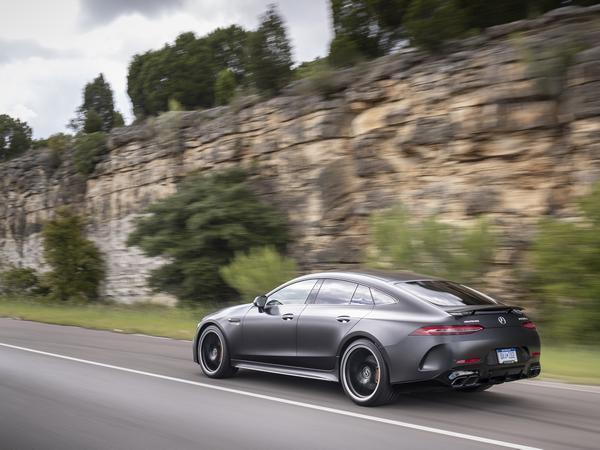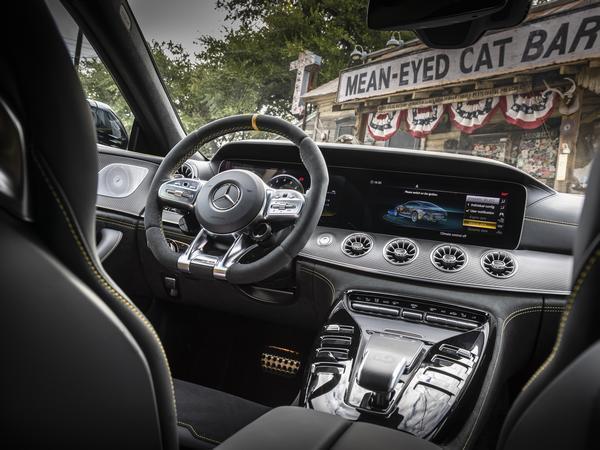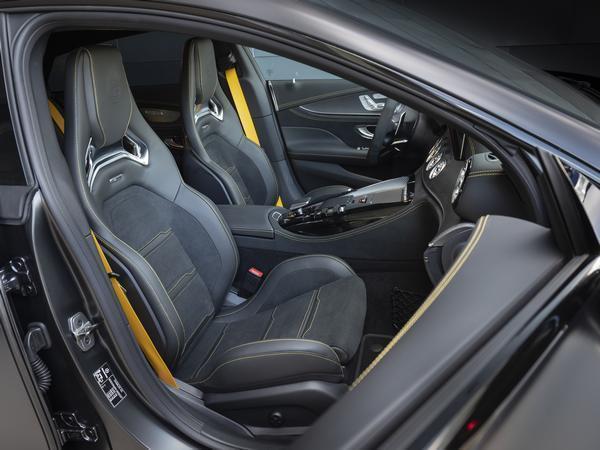2020 Mercedes-AMG GT 4-Door Coupe | PH Review
Even at two tonnes, the new GT 4-Door should be less cumbersome than its name. Is it any good, though?

The non-stop car business can be absolutely relied upon these days to provide new cars with daft names at amusingly regular intervals. A lot of these names quickly become so common a part of our lexicon that they're entirely normalised. I don't bat an eyelid anymore when I have to say Qashqai, Evoque, Levorg or Kadjar. And yet the best chance I'd have had at pronouncing any of them right at the first attempt would have been as part of one of those barely telegraphed, mid-sentence ambush sneezes.
But tricksy, misleading names don't slip so easily into the norm, do they? And I think Mercedes-AMG GT 4-Door Coupe is one such name. For reasons we'll get to, I just don't like it. But that's alright because neither does AMG boss Tobias Moers. Everyone's favourite slightly prickly, overly honest German petrolhead executive agreed, on the press launch of this car last week, that "hmmm, yes, maybe it is [a daft name]. I don't like 'GT 4-Door'. I prefer to call it GT 63."
Hmmm. Quite. My main beef is that calling this thing a 'GT' at all implies a closer relationship between this car and Mercedes-AMG's lightweight, spaceframed two-seat sports car than is even remotely correct - or, for that matter, particularly honest. The GT 4-Door shares the same monocoque 'MRA' platform that Mercedes' regular C-Class, E-Class and CLS use; and you'll have probably gathered as much on the basis that it looks like an angry/sexy/disguised CLS with a tweaked roofline and some pinched features. It's a bit like 'Wario' to the CLS's 'Super Mario', only sadly without the big teeth, hypnotic eyes and concertina 'tache.

This is the car that's brought about the demise of the old CLS 63; one that is alleged to present Mercedes-AMG's wealthier customers with a more daily-usable alternative to a two-door GT, but that's a proper, fully-fledged AMG-only model allthesame, with all of the Swabian hot rod fairy dust that implies.
And how is it actually technically different from an E63 S super saloon - a car which also has four doors and five seats and four-wheel drive and a twin-turbocharged V8? Well, the GT 4-Door's chassis is reinforced. It has four-wheel steering and its own suspension tuning. It has the firm's latest 'AMG Dynamics' multi-stage stability control (whose 'Master' setting may be worth the price of admission on its own simply for momentarily making you feel like some oversteer-preoccupied Yoda). It's available on Michelin Pilot Sport Cup 2 rubber, which you can't get on any other AMG '63 model (AMG GTs notwithstanding). And it has AMG's 4.0-litre twin-turbo V8 in yet another state of tune, this time stonking out 639 horsepower and 664lb ft of torque. The latter, by the way, is a good 30 per cent more pounds than any two-seater GT has stonked thus far.
The aforementioned underbody strengthening, among other things, makes the top-level GT 4-Door (the car's available in '63 and '63 S forms, the former wound down to a mere 585 horses) a touch heavier than an E63 S, but only by 100kg or so. It's comparable in that respect with, say, a Porsche Panamera Turbo. It is not comparable, of course, to the kerbweight of a 1.5-tonne spaceframe two-seater GT, needless to say - since the GT 4-Door's kerbweight stands at a shade over two tonnes. Just an idea, lads - but if you hadn't called it a 'GT', perhaps that wouldn't seem so lardy?
The interior of the GT 4-Door offers a level of four-seat practicality predictably similar to that of a CLS, but 'luxury performance' ambience of a cut above. The front seats are more deeply bolstered than any you'll find in any super saloon, though still comfy and easy enough to get in and out of. The controls and instruments seem familiar from wider Mercedes-AMG applications, although the car uses the firm's very latest steering wheel complete with auxiliary drive mode selector dial on its spoke.

But the cabin's most eye-catching feature is its swollen transmission tunnel console, similar in its volume to the one on the two-seater GT but stacked with new illuminated toggle switches (for transmission, suspension, drive and stability control modes, and the like) each of which has a tiny display screen to tell you how each system is currently set.
This is a complicated car, but I must say I quite liked how quick and easy those little displays made it to check your selected configuration of systems. They mean you don't have to look to one place to find the right button to press and then to another (usually at the instruments but sometimes the infotainment display) to check that the button you're actually pressing is having the desired effect. Not rocket science, is it? You look where you're fiddling.
While we're touching on the subject of complexity, is the fact there's so much of it here a bit of a turn-off for the driver? You might imagine it would be, but the way these all-singing-and-dancing modern AMGs corral the settings of their various active systems into driver-mode combinations of noisy-this, medium-stiff-that and rear-biased-the-other certainly minimises the brain ache.

Predictably enough, the GT 4-Door makes a better fist of 'comfort' mode than the regular GT ever did, riding with decent suppleness, responding to pedal inputs with laid-back moderation, shifting smoothly, and generally keeping an airtight lid on the high-strung feistiness that can be the undoing of its two-door rangemate. In that respect, however it might have handled ultimately, the car's already a success: already so unlike any SLS or GT in as much as it can play the becalmed, practical everyday driver so well.
Dial up 'sport' or 'sport+' and stoke it a bit harder on the road and the GT 63 S gives plenty back, without ever feeling quite as light, pointy or exciting as a proper sports car. The 4Matic+ four-wheel drive system sends 100 per cent of torque rearwards until those rear wheels run short of grip, and so the car handles with the balance and involvement of a rear-driver even in four-wheel drive mode. Send the car fast into a bend and drive it hard on the way out and there is clearer poise and handling adjustability here than you get in an E63 S, I'd say; better, flatter body control, too. There's clearer tactile steering feel, and just a touch of stabilising steady-state understeer to work through as you turn in, of the kind which is actually quite welcome in a big, powerful, front-engined car.
And then there's drift mode. This is at once the only mode in which your average motoring journalist would want to drive once he's negotiated the tummy-rubbing-while-head-patting routine necessary to engage it; and yet also the one an owner would probably be least inclined to risk his new acquisition by using. Should you feel differently, you need 'race' driving mode dialled up to engage it, then stability control fully off (a long press, not just 'sport handling' mode) and transmission in manual. Now pull both shift paddles simultaneously and hold them, as if you were grabbing a Weimaraner pup by the lugholes and roughing him up for a tussle on the carpet. One more solitary tug on the right paddle is necessary to confirm your intent. Playtime can commence.

The Circuit of the Americas in Austin, Texas, which Mercedes-AMG is currently annexing for a good fortnight for the press launch of this car, has no shortage of tight third gear turns for the GT 4-Door to drift around. One of them is a particularly long double-apex right-hander, around which some of this car's two-tonne, four-wheel drive rivals might have been equally fast and flat, but few would have been as much fun.
The AMG's steering feels tactile and trustworthy, rather than elastic and over-assisted as some comparable GTs present it, and it inspires instant confidence. If the rear axle's doing things to help the car into a slide, or to stabilise it thereafter, they're undetectable things - so the car's handling is entirely natural and predictable. The suspension controls the car's considerable mass effortlessly as the lateral cornering load ebbs and flows. The V8's titanic mid-range torque comes on stream in the blink of an eye.
The skids are alright, in other words: easier to cue up and more indulgently extendable than in a BMW M5 or a Porsche Panamera Turbo. And when you get bored with them and want to go back to behaving like a grown up, the car's ready to mould itself around you. It's a really multi-faceted driver's car.
More importantly, as we covered before, it's a proper GT: one in true nature as well as in name for the first time from Affalterbach's line of upper-level special models. It's a smart addition to AMG's range, it does feel more special to drive than a CLS 63 quite managed, and so it deserves our collective attention.
But it also deserved a clearer identity of its own (nope, still not over it; sorry to bore on). And, at a time when other car makers appear to be using random gobbledegook generators to come up with model names that take all of five minutes to become accepted and familiar, I'm still baffled as to why Mercedes-AMG didn't give it one.
Matt Saunders
SPECIFICATION: MERCEDES-AMG GT 63 S 4-DOOR COUPE
Engine: 3,982cc, V8, twin-turbo
Transmission: 9-speed 'multi-clutch' transmission, 4Matic+ 4WD
Power (hp): 639@5,500-6,500rpm
Torque (lb ft): 664@2,500-4,500rpm
0-62mph: 3.2sec
Top speed: 196mph
Weight: 2,045kg
MPG: 25.2mpg
CO2: 256g/km
Price: £135,000





Gassing Station | General Gassing | Top of Page | What's New | My Stuff



